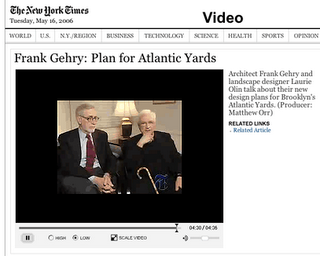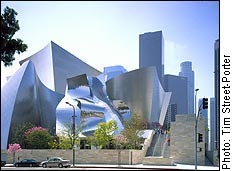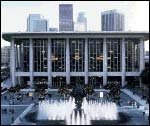 The ads for Sydney Pollack's new documentary Sketches of Frank Gehry excerpt words from reviews: “absorbing,” “seductive,” “superb,” and “a very fine documentary about our era’s master builder. Refreshing, instructive, and satisfying.”
The ads for Sydney Pollack's new documentary Sketches of Frank Gehry excerpt words from reviews: “absorbing,” “seductive,” “superb,” and “a very fine documentary about our era’s master builder. Refreshing, instructive, and satisfying.” Yes, Gehry’s designed some terrific buildings and had an important influence on architecture--and the camera loves the curves of the Guggenheim Bilbao and other sinuous structures. But international fame does not equal responsiveness to the community. While the film makes no reference to the Atlantic Yards project, but, viewed through a Brooklyn-centric lens, it offers offers some unencouraging hints: Gehry comes off as artist, not urban planner, is shown to possess a monumental ego, and appears to have been more concerned about being a "good neighbor" in Los Angeles than in Brooklyn.

(At left, the director and his subject, old friends.)
[Architect Jonathan Cohn has some more reflections today on the role of the architect and the scale of the project, concluding it should be drastically reduced, beyond even that proposed by Assemblyman Jim Brennan.]
Art, not planning
Gehry is far more rooted in the world of art than urban planning; many of the enthusiasts quoted are artists. “If I have a big envy in my life, it’s about painters. I wish I was a painter,” Gehry declares at one point. Client (and former superagent/Disney president) Michael Ovitz declares the architect “a contemporary cubist and sculptor." In the early 1960s, “he was completely aligned with artists," said artist Ed Ruscha, citing Gehry’s presence at exhibits and parties. Gehry said he felt his profession hidebound and unsupportive, while the artists “were treating me like I was part of the team.”
“There are sort of rules about architectural expression, you have to fit into a certain channel," Gehry declares. "Screw that—it doesn’t mean anything. I’m going to do what I do the best. If it’s not good, the marketplace will deny it.”
 Former Disney CEO Michael Eisner describes Gehry’s design for Disney Ice (now Anaheim Ice), a practice rink for the Anaheim Mighty Ducks. “You give Frank the functionality… and he delivers the picture.”
Former Disney CEO Michael Eisner describes Gehry’s design for Disney Ice (now Anaheim Ice), a practice rink for the Anaheim Mighty Ducks. “You give Frank the functionality… and he delivers the picture.”Gehry can deliver functional buildings, but a functional building does not mean functional urban planning, not with 16 towers and an arena. (Update 5/29: Indeed, according to eyewitness reports posted by the Project for Public Spaces, the Guggenheim Bilbao makes for an awkward public space.)
The picture of Miss Brooklyn (right) does not mean that the neighborhood would be functional.
The work of an architect
Not only is there nothing in the film about urban planning, there's little about the complicated work of an architect. The film focuses exclusively on the art of conjuring up shapes. As Eva Hagberg wrote 5/8/06 in a critique on HuffingtonPost, "You hope there might be a couple shots of Gehry thinking about a budget, or playing with circulation, or discussing the program, or even--heaven forbid--talking to a client. Instead, there are only slyly self-aware nods to the consistent difficulty of the profession, small critical moments where it seems almost plausible that Pollack might rip open the slickly schlumpfy image Gehry so comfortably projects."
 So maybe Gehry really doesn't care about meeting with the Brooklyn community so concerned about the arena and 16 towers of the Atlantic Yards project. (Pollack, who admits in the film that he knows nothing about either architecture or documentaries, told Hagberg that "people would fall asleep" if he showed the pesky reality of architectural practice.)
So maybe Gehry really doesn't care about meeting with the Brooklyn community so concerned about the arena and 16 towers of the Atlantic Yards project. (Pollack, who admits in the film that he knows nothing about either architecture or documentaries, told Hagberg that "people would fall asleep" if he showed the pesky reality of architectural practice.)The Gehry style
Gehry's self-deprecating style masks a fierce competitiveness. Thomas Krens, director of the Guggenheim Foundation, observes, “Somebody asked me once about Frank’s ego. I said: You shouldn’t be put off by the kind of Columbo-like exterior. Y’know, the crumpled raincoat and the sort of shuffling, self-effacing manner. Frank’s got the biggest ego in the business.” Krens, with respect, adds that Gehry does his revisions "from a higher plane."
Gehry tells Pollack that, when faced with criticism, “I act like nothing’s happening, aw shucks... I’m competitive as hell, but I cover it up... I want to be a nice guy…yet I am ambitious. I think it’s the same with the work.”
Ok, does mean that "nice guy" Gehry wants to meet with the community, but "ambitious" Gehry won't cross his client, who has given him the opportunity to design his first sports arena--and, as Gehry said, "build a neighborhood from scratch in an urban setting"?
 Indeed, Gehry's combativeness has recently surfaced; at the Atlantic Yards press conference 5/11/06, Gehry cracked that his critics "should've been picketing Henry Ford," and “People aren't riding around on horseback anymore.” (Tidbit: Design work in Gehry’s office has been revolutionized by digital technology, but “Frank still doesn’t know how to use a computer,” declares Krens, "except to throw it at somebody." So who's mired in horseback days? At right, Gehry and landscape architect Laurie Olin in a New York Times video interview.)
Indeed, Gehry's combativeness has recently surfaced; at the Atlantic Yards press conference 5/11/06, Gehry cracked that his critics "should've been picketing Henry Ford," and “People aren't riding around on horseback anymore.” (Tidbit: Design work in Gehry’s office has been revolutionized by digital technology, but “Frank still doesn’t know how to use a computer,” declares Krens, "except to throw it at somebody." So who's mired in horseback days? At right, Gehry and landscape architect Laurie Olin in a New York Times video interview.)The role of the client
“I don’t go after the job anyway,” Gehry says. “I wait til the jobs hit me on the head. I don’t like rejection… I accept the projects based on whether I like them—the people.” Note that Gehry has already said of his patron for Atlantic Yards: "Bruce Ratner is politically my kind of guy, he's a do-gooder, liberal, we can talk, he likes classical music, and he collects art. So he's a guy I can play with."
Mildred Friedman, a curator and critic who edited a book about Gehry, suggests “Frank has figured out that the most important influence on the design is the client. And if there’s a terrific client to work with, you get a terrific building. If there isn’t, you don’t.”
 So is Bruce Ratner (right, image from FCR site) a terrific client? Gehry has said that "this developer’s is interested in doing something special. Their history is, they haven’t, but now they want to. I took them at their word, and they have been very fastidious in supporting the things that I think are important." Then again, Gehry also has acknowledged that he wanted to bring in other architects, and that's been denied.
So is Bruce Ratner (right, image from FCR site) a terrific client? Gehry has said that "this developer’s is interested in doing something special. Their history is, they haven’t, but now they want to. I took them at their word, and they have been very fastidious in supporting the things that I think are important." Then again, Gehry also has acknowledged that he wanted to bring in other architects, and that's been denied.  Also, while Gehry predicted that the scale of the project is "coming way back," the recent five percent scaleback suggests that the client disagrees. Gehry now uses the term "paring back." And is it Gehry or Ratner who's responsible for the deceptive renderings that, had they portrayed the views from a few feet away, would show more massive towers? (Dean Street example at left.)
Also, while Gehry predicted that the scale of the project is "coming way back," the recent five percent scaleback suggests that the client disagrees. Gehry now uses the term "paring back." And is it Gehry or Ratner who's responsible for the deceptive renderings that, had they portrayed the views from a few feet away, would show more massive towers? (Dean Street example at left.)Gehry learned a lesson from his old friend Pollack, he says in the film: "I was struggling with the world I was confronted with, the commercial world, they weren’t interested in what I was doing… you said you made peace with it by finding this small percentage of space in that commercial world where you could make a difference."
How big is that space, and are there compromises you don't make? In January, Gehry said, "If I think it got out of whack with my own principles, I’d walk away." For now, though, he's promoting the Atlantic Yards plan in visits to editorial boards, such as this 5/14/06 interview with the Daily News editorial board. (Note that the Daily News claims three acres of green space over the arena roof, while the Final Scope promises (p. 3) one acre of private open space; the newspaper neglected to clarify that, as it has reported previously, the arena roof was originally promised as publicly-accessible park space.)
Some glimpses of Frank
Fiddling with some sketches, Gehry at one point says delightedly, “That’s so stupid-looking, it’s great,” and lets out a wordless cry of glee. (The folks at the Gutter should have a field day with that one.)
 Gehry also evinces an impressive capacity to turn on a dime, with little apparent regret about the collateral damage. (He wouldn't be the only artist with this pattern.) After he designed the Santa Monica Place, mall for the Rouse Company, he invited the company president to his home (right), a multitudinous product of his creativity, a new structure built around an existing house.
Gehry also evinces an impressive capacity to turn on a dime, with little apparent regret about the collateral damage. (He wouldn't be the only artist with this pattern.) After he designed the Santa Monica Place, mall for the Rouse Company, he invited the company president to his home (right), a multitudinous product of his creativity, a new structure built around an existing house. Why’d he work on the mall, so different from his house, Gehry was asked. “Because I had to make a living,” the architect replied. “He said ‘stop it’… I said ‘You’re right.” So Gehry and the Rouse official decided to part ways. “It was like jumping off a cliff, an amazing feeling. And I was so happy from then on.” On camera, Gehry expresses no qualms about the 45 staffers in his office laid off without notice, but maybe Pollack didn't ask.
Milton Wexler, Gehry’s longtime therapist, recounts how Gehry was in limbo with his wife, and advised him to make up his mind, to either commit to work it out or to leave immediately. Gehry instantly moved to a hotel. “I had two daughters and a wife,” he says with a mildly incredulous laugh. (His second wife appears in the film, but not his children.)
The European tour
 Rocker Sir Bob Geldof describes the wonder of seeing Gehry’s Vitra Design Museum in Weil am Rhein, Germany. Geldof declares architecture “shite” 99 percent of the time, and says he usually adheres to Auberon Waugh’s dictum that “should you meet an architect at a party, the best thing one can do is hit them.” (Would some Brooklynites share those sentiments? Or are they too busy cleaning their stables?)
Rocker Sir Bob Geldof describes the wonder of seeing Gehry’s Vitra Design Museum in Weil am Rhein, Germany. Geldof declares architecture “shite” 99 percent of the time, and says he usually adheres to Auberon Waugh’s dictum that “should you meet an architect at a party, the best thing one can do is hit them.” (Would some Brooklynites share those sentiments? Or are they too busy cleaning their stables?) As for Bilbao (right), it sure looks good. But Princeton critic Hal Foster, who appears in the film as the obligatory naysayer, writes that it serves as a logo: "Bilbao uses its Gehry museum this way: it appears on the first sign for the city you see on the road, and it has put Bilbao on the world-tourist map."
As for Bilbao (right), it sure looks good. But Princeton critic Hal Foster, who appears in the film as the obligatory naysayer, writes that it serves as a logo: "Bilbao uses its Gehry museum this way: it appears on the first sign for the city you see on the road, and it has put Bilbao on the world-tourist map."In the film, a Bilbao journalist enthuses, “Community self-esteem has increased so much.” Then again, as James Russell writes, "A program of public investment in airports, a subway, and other cultural facilities reinforced the job the museum did of putting the city on the map."
So, does Brooklyn need Gehry for self-esteem? For sports? What about the public investment in infrastructure and cultural facilities? Or an actual policy on affordable housing?
The critics speak
 Princeton critic Hal Foster (left) is the only critic on camera (though there is a shot of an article disparaging Gehry’s Experience Music Project in Seattle). Gehry’s buildings are more spectacle than functional, Foster suggests; “There are moments when he has delivered the goods too quickly….A sublime space that overwhelms the viewer and a spectacular image that can circulate through the media and around the world as brand.”
Princeton critic Hal Foster (left) is the only critic on camera (though there is a shot of an article disparaging Gehry’s Experience Music Project in Seattle). Gehry’s buildings are more spectacle than functional, Foster suggests; “There are moments when he has delivered the goods too quickly….A sublime space that overwhelms the viewer and a spectacular image that can circulate through the media and around the world as brand.”  In rebuttal appears former Times architecture critic Herbert Muschamp (right), damning the pressures on architects to be “appropriate.” He continues: “And it still is the big word, which means blend in, nobody notices, camouflage. Put up a new 70-story office building but make it look like a little Art Deco thing next door. Who gets anything about that? You have to not only talk about the freedom but you also have to talk about the courage of an architect who has convictions to say, ‘Well, that’s not what architecture should be doing, and that’s not what cities should be doing.’”
In rebuttal appears former Times architecture critic Herbert Muschamp (right), damning the pressures on architects to be “appropriate.” He continues: “And it still is the big word, which means blend in, nobody notices, camouflage. Put up a new 70-story office building but make it look like a little Art Deco thing next door. Who gets anything about that? You have to not only talk about the freedom but you also have to talk about the courage of an architect who has convictions to say, ‘Well, that’s not what architecture should be doing, and that’s not what cities should be doing.’”Does any critic hit the spot? “When I see something negative, I try it on… for size," Gehry responds. "I wear it and think, ‘maybe there’s something there,’ I look at it. I must get something out of it… but I don’t digest it intellectually." Ultimately, Gehry says, “I just keep going, I don’t pay attention. I mean, what am I going to do?”
Foster appears again, saying, "As a critic, it’s incumbent upon me to take an emphatic stand, to hold a line of disagreement, so that other people are not simply caught up in the culture of affirmation… that has surrounded Gehry."
Immediately following him, Muschamp raises the stakes: “This is the only history that we’re going to be living in, ok, this is the one. You can read about the ones that came before, this is the one that’s happening now. And fortunately, there are a few people who understand how to respond to these challenges, and Frank Gehry is one of them. There’s only so much that architecture can do, but what he’s serving is the 'so much,' and trying to realize it.”
 Artist Julian Schnabel, in his bathrobe, shades, and a drink in his hand, opines, “I wouldn’t criticize him, 'cause I think it’s like flies flying around on the neck of a lion. It’s like watching a movie like Apocalypse Now and saying you think that Robert Duvall is over the top.”
Artist Julian Schnabel, in his bathrobe, shades, and a drink in his hand, opines, “I wouldn’t criticize him, 'cause I think it’s like flies flying around on the neck of a lion. It’s like watching a movie like Apocalypse Now and saying you think that Robert Duvall is over the top.”Good neighbor in LA
 Gehry allows, “Because buildings take so long to realize, by the time I get to the finished building, I don’t like it…” The film ends at Walt Disney Concert Hall, (above right) which opened in 2003, where Gehry was faced with interacting with the 1960s-era Dorothy Chandler Pavilion (left). He tells Pollack: “The only thing an architect can do is be optimistic about how it interacts with the surrounding buildings. It can be a passive player, it can be a stoic player, it can be a passionate player.”
Gehry allows, “Because buildings take so long to realize, by the time I get to the finished building, I don’t like it…” The film ends at Walt Disney Concert Hall, (above right) which opened in 2003, where Gehry was faced with interacting with the 1960s-era Dorothy Chandler Pavilion (left). He tells Pollack: “The only thing an architect can do is be optimistic about how it interacts with the surrounding buildings. It can be a passive player, it can be a stoic player, it can be a passionate player.” "My feeling is, I don’t like the Chandler, it’s not great architecture, but it’s here and people have a lot of feelings about it, it’s part of the community, so you have to respect that, whether you like it or not. That’s like being a good neighbor. And so I tried to make a building that would preserve the iconic importance of the Chandler. To defer to that, I decided to bring down the scale of the Disney Hall into smaller pieces, so it’s not the same language.” (At right, the Chandler is visible slightly in the far right of the frame.)
"My feeling is, I don’t like the Chandler, it’s not great architecture, but it’s here and people have a lot of feelings about it, it’s part of the community, so you have to respect that, whether you like it or not. That’s like being a good neighbor. And so I tried to make a building that would preserve the iconic importance of the Chandler. To defer to that, I decided to bring down the scale of the Disney Hall into smaller pieces, so it’s not the same language.” (At right, the Chandler is visible slightly in the far right of the frame.)Good neighbor in Brooklyn?
It makes you wonder: how does Gehry feel about the fact that Miss Brooklyn--his self-described "ego trip"--also obscures the views of the iconic Williamsburgh Savings Bank? Is that being a good neighbor? (Image below from DDDB.)
 As noted in my letter to the editor of the Brooklyn Papers 3/27/04 issue (p. 8 of PDF), at a public meeting on the Atlantic Yards plan sponsored by the Park Slope Civic Council, architect Tensho Takemori, of Frank Gehry Partners, was asked why one of the planned office towers must be taller than the Williamsburgh Savings Bank building and why, as a gesture of respect, couldn’t the latter remain the borough’s tallest building.
As noted in my letter to the editor of the Brooklyn Papers 3/27/04 issue (p. 8 of PDF), at a public meeting on the Atlantic Yards plan sponsored by the Park Slope Civic Council, architect Tensho Takemori, of Frank Gehry Partners, was asked why one of the planned office towers must be taller than the Williamsburgh Savings Bank building and why, as a gesture of respect, couldn’t the latter remain the borough’s tallest building.His answer was hardly convincing: “We want them all to be speaking together. By having one taller, it serves to integrate the existing buildings into the landscape.”
Rather, it trumps the Williamsburgh Savings Bank tower and--as the current design shows--even "blocks the clock." After all, it is an "ego trip," as Gehry acknowledges. No one from his firm has appeared at a public forum since then.
Gehry's anxieties
Asked if he ever gets depressed, Gehry responds: "A little bit… you know that better than I do. You can’t let go. When I let go is a year later, after test of time, didn’t leak, people like it." Miss Brooklyn might take three years, but Atlantic Yards wouldn't be done until 2016. Gehry was born in 1929; the odds are lower that he'd see the whole thing through.
Is there anything you haven’t done that you want to do, Pollack asks. Gehry shrugs it off: "I’m superstitious, so I never say that. When you’re a younger architect, starting out, you’re seeking some kind of impossible perfection. You can spend your life thinking about this ephermal building that would be great to do, it would be the capstone of my career. And you realize as you mature that there’s no there.”
Maybe Gehry gave his answer before the day in 2003 when he began talking to Ratner about the Atlantic Yards project (first arena! new neighborhood!). But his comments in recent interviews have shown him both anxiety-ridden and defensive about the Atlantic Yards project. Had they been included, they would have offered some more shadings on the challenges Gehry faces.
Changing the world
The film closes with the shrink Wexler, who declares, “A great many people come to me, hoping they can that they can change themselves and settle their anxieties, their problems in their marriage, or whatever. They want to know how to handle life better. When an artist comes to me, he wants to know how to change the world.”
And, in this case, apparently, Brooklyn.
For those who'd rather not pay to see the film in a theater, it will air on PBS on 9/20/06--just before construction begins for the Atlantic Yards project, according to FCR's projected timetable or, quite possibly, in the midst of continued community challenge, flies on the neck of a lion.
Comments
Post a Comment